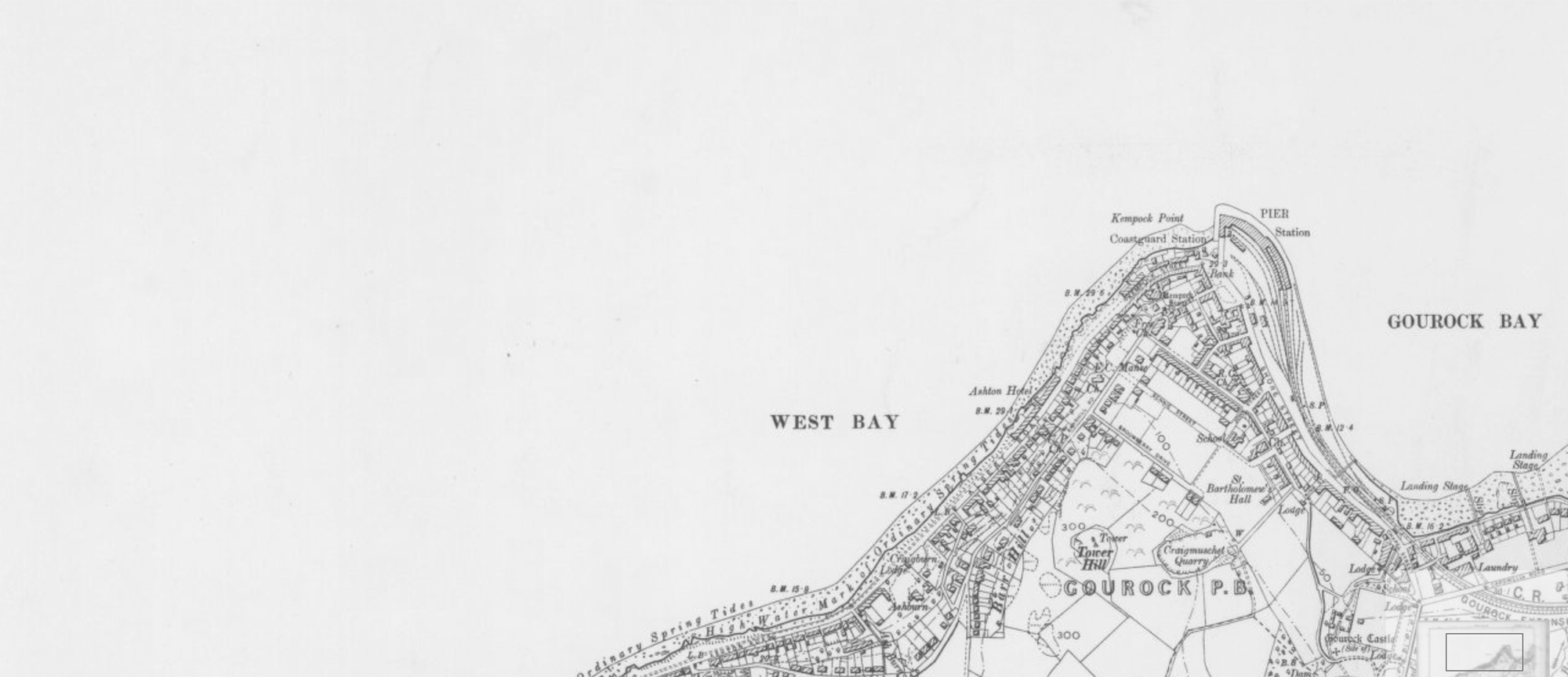
Gourock
from Renfrewshire I.NE & NW revised1896: Reproduced with the permission of the National Library of Scotland
Gourock lies Immediately to the west of Greenock, hugging the hills, as the Firth of Clyde opens out into the sea.
The name of Gourock comes from the Scottish Gaelic 'Guireag' which means pimple-shaped or rounded and refers to the hill above the town, probably Tower Hill.
Gourock's first historical reference was in 1494 when King James IV of Scotland sailed for the Western Isles from Gourock Bay.
‘Nothing but bare hills, the mystic Kempoch Stone perched on the edge of the precipice; a bridle path along the coast; a bleak and bouldery shore; Kempoch Point, … striding out into the Firth and guarding the lonely little anchorage that lay within. But on that day, what a stir! Galleys, with streaming pennons, moored in the bay; armed men and sailors swarming on the shore; … King James and his nobles coming down to embark … (then)… the ships, amidst the wild chants of the seamen, spread their canvas and sailed down the Firth for the Mull of Kintyre and the far off Hebrides; the Governor of Gourock Castle was back into his little stronghold; and the bay and the bleak untenanted shores were left to their native loneliness.‘
David MacRae’s ‘Notes about Gourock’, 1880.
The Estate of Gourock was owned by the Earls of Douglas. In 1452, William, the 8th Earl was invited by King James II as a guest to Stirling Castle where the King stabbed him and threw him out of the castle window. After his descendants raised a rebellion which failed, the estates of the 9th Earl were forfeit, including the Barony of Finnart. This Barony was divided by the king into two baronies; the eastern portion was granted to the 1st Earl of Arran and retained the name Finnart; the western portion was bestowed on the Castlemilk branch of the Royal Stewart family and became known as the Barony of Finnart-Stewart and interchangeably referred to as Gourock.
In 1694, the whole lands of Gourock became a free barony and the following year was erected a Burgh of Barony. The estate remained in the property of the Stewart of Castlemilk family for 300 years when it was sold in 1784 to Duncan Darroch.
Gourock Pier, 1880s
Beginning as a fishing village, Gourock was the first place to cure herring in Great Britain. This salting treatment meant the fish could be packed into barrels and last for several months. Long enough to export across the Atlantic!
A prehistoric monolith known as ‘Granny Kempock’ sits on a cliff overlooking Kempock Point. About 6 feet high, local lore said that sailors and fishermen used to walk with a basketful of sand around it seven times, incanting songs asking for safe voyage. Marriages were not regarded as lucky unless the bride and groom passed round the stone obtaining Granny Kempock's blessing.
In 1662, several woman were tried for witchcraft, one of which, a young girl called Mary Lamont, aged 16, was reputed to be in league with the devil. She confessed to dancing around the stone with the devil as part of a plot to throw the stone into the sea to destroy ships. Having confessed, she was burned at the stake, possibly at the Auld Kirk, Inverkip.
A rope works was started in 1736 and became the largest in Scotland at that time. It relocated to Port Glasgow, but still maintained its name - Gourock Ropework Company.
With its promise of exceptional scenery and invigorating air, Gourock was a key destination for workers from the west of Scotland to travel “doon the watter” and spend their holidays on the coast or as a gateway to jump onto the steamers and cruise the Clyde, visiting its many isles.
Further information:
Notes about Gourock by David MacRae
Gourock, Historical Perspective by Francis Groome
Image: Granny Kempock Stone - Creative Commons Attribution-Share Alike ©rosser1954
Copyright images: McLean Museum and Art Gallery: Gourock Pier; Granny Kempock Stone


